- Offensive Techniques & Strategies

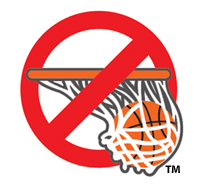
The Case for the Defense
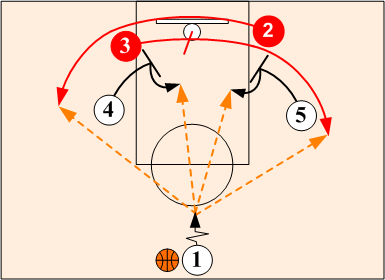
Since the Power Offense involves continuous screening action on both sides of the court, if any of the defenders get hung up on a single screen it will most certainly result in a wide open shot for the opponent's best shooters. Players must possess a good working knowledge on how to disrupt down and base screens.
Power's Schematic Sequence

Defensive Fundamental Skills Required
Defensive Strategies & Techniques Used To
Combat the Power Offense


Basic NBA Show & Recover

Since the Power Offense involves "Bigs" screening for "Smalls" most NBA teams do not like to switch. If the defense switches, the shooters will simply fade to the corners allowing the screener to post up against the smaller defender. Therefore, "Show and Recover" is the preferred method used in the NBA to defend against Power's screening actions. However, defensive tactics will vary from one team to another and from player to player.
Phase 1. Defending the Baseline Crossing Action
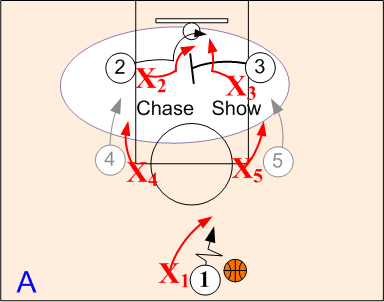
In defending the shooters crossing under the basket, defender X3 guarding the screener O3 will step out ("Show") and force shooter O2 wide. Defender X3 then "Recovers" quickly back to O3. Defender X2 chases O2 out over the screen. On-Ball defender X1, pressures the ballhandler hard toward the sideline.
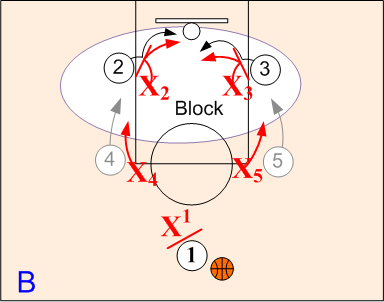
In cases when shooters O2 and O3 are extremely adept in using baseline screens, defenders X2 and X3 can simply physically block and prevent O2 and O3 from crossing under the basket.
Phase 2: Defending the Down Screens
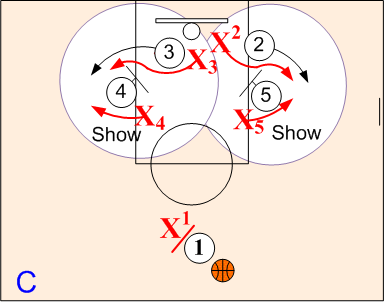
Show. Defensive players X4 and X5 step out hard and "SHOW" forcing the shooters coming off O4's and O5's down screens wide. Defenders X2 and X3 chase out hard against O2 and O3.
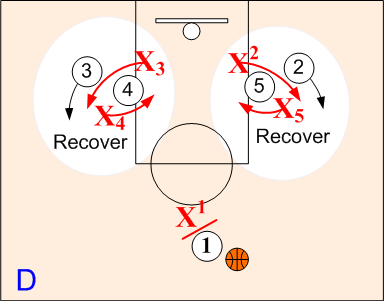
Recover. After the screen, defenders X4 and X5 quickly release and "Recover" (dive) back to the screeners O4 and O5 assuming a strong three quarter pass denial position against screeners O4 and O5 posting up. Defenders X2 and X3 chase out and assume pass denial positions against shooters O2 and O3.
Final Phase: Matching Up
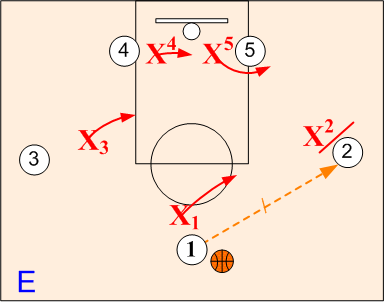
When ball is passed to O2 on wing, defender X2 pressures the ballhandler. Post defender X5 assumes a three quarter denial or plays behind post O5, physically pushing O5 away from the low block area. Weakside players X1, X3 and X4 "pack" it in toward the ball maintaining ball/man vision.
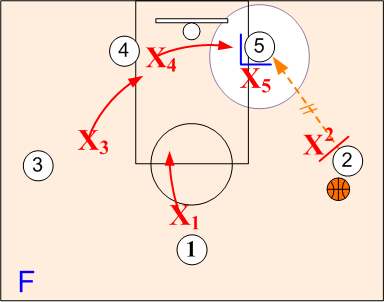
Note: Most NBA teams will also be prepared to trap on any post mismatch. They have the options of double teaming the post using any one of the weakside defenders.


All Out SOS Disruption

Power Offense
Total disruption of the Power Offense is achieved by having the defense initiating the action and trapping the shooter on the wing. The shooter is very vulnerable to this wing trap because the point guard is going away and setting a weakside screen for the opposite wing. In attacking and trapping the shooter, it forces the offensive players out of their planned routes and into a "free lance" situation. Once in this free lance mode, the defense can gain an advantage with execution of their SOS basic defensive fundamentals and team concepts.
Phase 1A. Sideline Push (Preventing Mid Penetration)
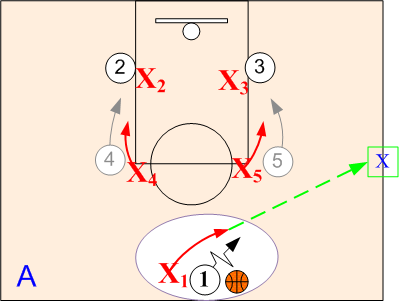
Defender X1 assumes an aggressive On-Ball Set position forcing the ballhandler O1 toward a sideline pushpoint, , preferably to their weak hand, preventing mid penetration. Pushing the ballhandler toward the sideline also will initiate helpside defense action.
Note: It is best to pick up and push O1 to the sideline before crossing the midcourt line in an effort to force a high pick up and a longer passing lane. Half court traps can also be used very effectively.
Phase 1B. Invert (When Possible)
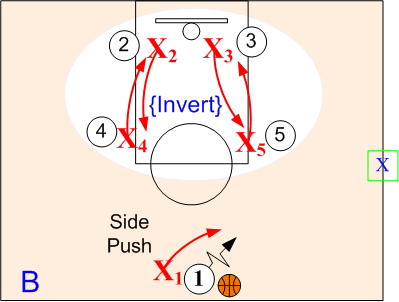
Whenever it is possible, defenders X4 and X5 should INVERT (switch) defensive positions with X2 and X3 to keep "Bigs" inside.
Phase 2. Defending the Baseline Crossing Action
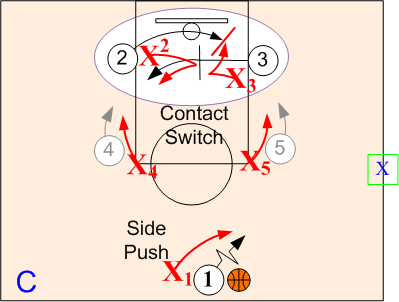
"Contact" switches on baseline screens are made by X2 and X3. Defenders X4 and X5 assume Snuggle positions on screeners O4 and O5. Defender X1 pushes O1 out of the mid court area to a sideline pushpoint.
Phase 3. Defending the Down Screens
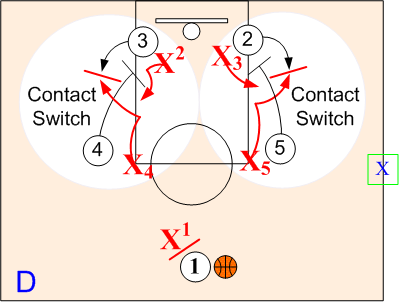
"Contact" switches on the down screens are made with defenders X4 and X5 stepping out into the passing lanes and assuming hard Snuggle denial positions against O2 or O3 coming off the down screens. Defenders X2 and X3 assume Snuggle denial postions against screeners O4 and O5 in the low post areas.
Phase 4: Wing Double Team (Trap)
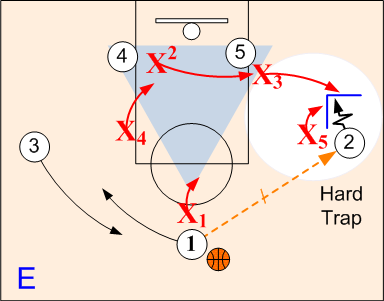
When point passes to shooting guard O2 on wing, X5 assumes an on ball Set position, influencing O2 to baseline checkpoint. Post defender X3 steps out and double teams O2 with X5 as O2 receives the pass. Defensive player X2 rotates over to a post front position and denies any pass to O5. Weakside defender X4 moves down to a low Triangle "I" position, and X1 assumes a high Triangle "I" position denying any reversal pass out of the trap.
Phase 4. Pass Out of Trap
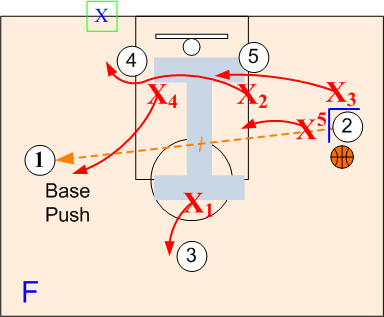
When O2 passes out of the trap to open O1 on wing X4 closes out and assumes an on ball Set position forcing O1 to baseline checkpoint. Defender X1 closes out to a Snuggle pass denial position on O3. X2 rotates back and Fronts O4 in the post area. X3 releases to a Low Helpside "I" Strike position against the O5 and X5 rotates to a mid Helpside "I" Strike position.
Caution: All rotations must take place as ball leaves passer's hands.
Players rotate according to O1's actions.
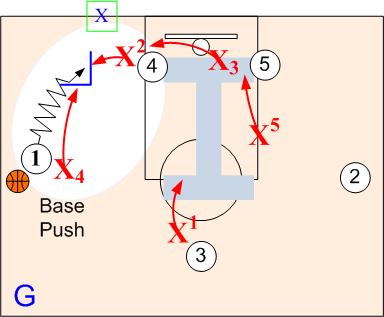
If O1 drives base, "Base Go I" or at the coach's discretion, "Base Go Red" scenarios are in effect. Defender X4 traps O1 with X2. Defender X3 rotates over to post O4, as X5 drops down to a low Triangle "I" position against O5. Defender X1 drops to the high Triangle "I" position ready to close out to O2 or O3 on O1's pass out of the trap.
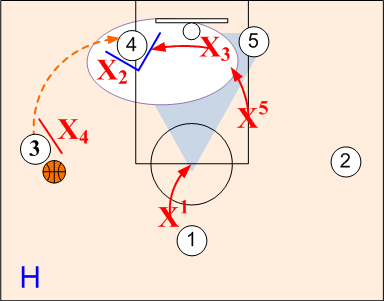
If wing O3 passes over X2's post front to O4, defender X3 covers and traps O4 with X2 while X5 drops to low Triangle "I" positon and X1 moves to the top Triangle "I" position.
If screening game is initiated, basic SOS defensive rules are in effect.
© 2026 HoopTactics All Rights Reserved.
